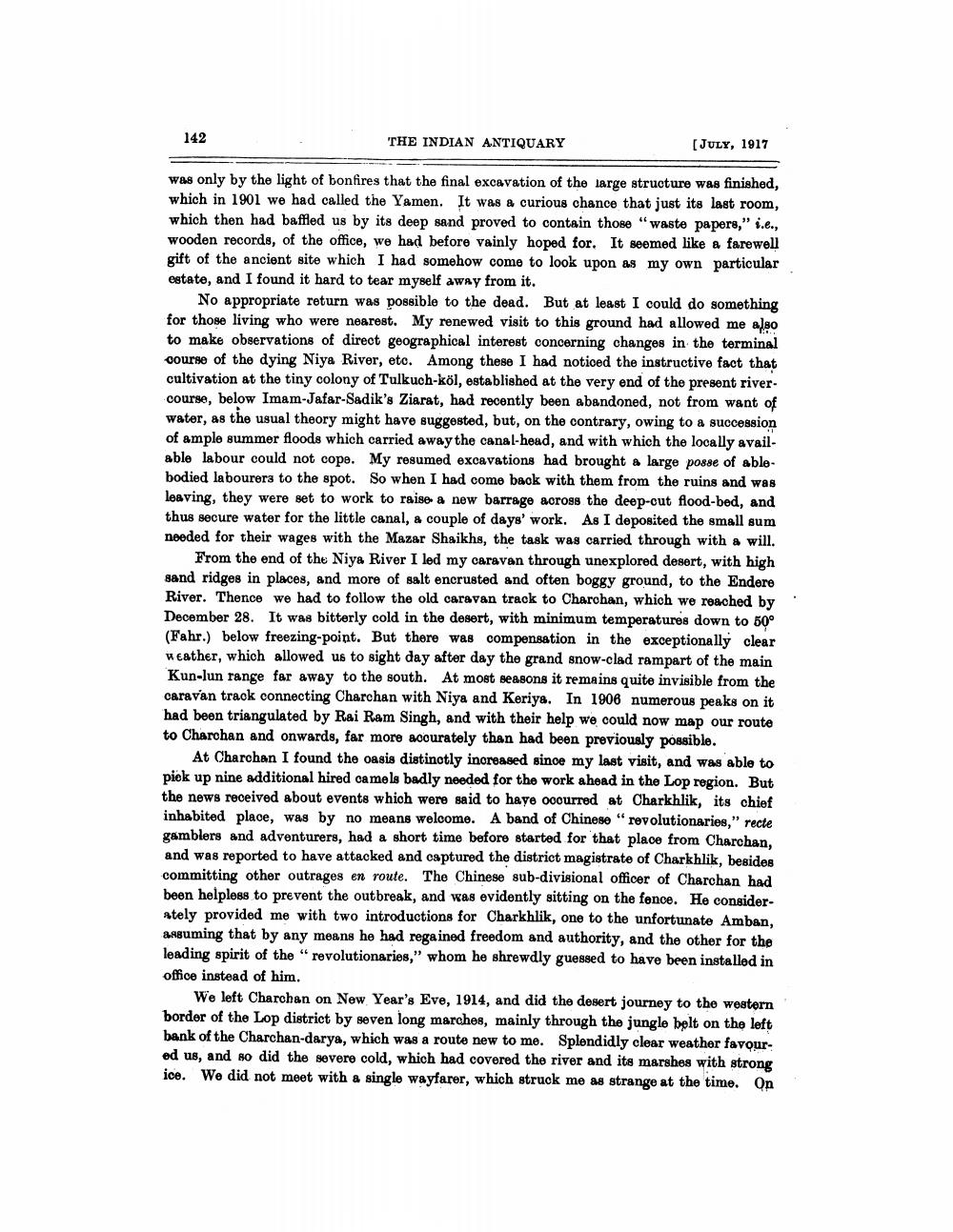________________
142
THE INDIAN ANTIQUARY
[JULY, 1917
was only by the light of bonfires that the final excavation of the large structure was finished, which in 1901 we had called the Yamen. It was a curious chance that just its last room, which then had baffled us by its deep sand proved to contain those "waste papers," i.e., wooden records, of the office, we had before vainly hoped for. It seemed like a farewell gift of the ancient site which I had somehow come to look upon as my own particular estate, and I found it hard to tear myself away from it.
No appropriate return was possible to the dead. But at least I could do something for those living who were nearest. My renewed visit to this ground had allowed me also to make observations of direct geographical interest concerning changes in the terminal oourse of the dying Niya River, eto. Among these I had noticed the instructive fact that cultivation at the tiny colony of Tulkuch-köl, established at the very end of the present river. course, below Imam-Jafar-Sadik's Ziarat, had recently been abandoned, not from want of water, as the usual theory might have suggested, but, on the contrary, owing to a succession of ample summer floods which carried away the canal-head, and with which the locally available labour could not cope. My resumed excavations had brought a large posse of ablebodied labourers to the spot. So when I had come back with them from the ruins and was leaving, they were set to work to raise a new barrage across the deep-cut flood-bed, and thus secure water for the little canal, a couple of days' work. As I deposited the small sum needed for their wages with the Mazar Shaikhs, the task was carried through with a will.
From the end of the Niya River I led my caravan through unexplored desert, with high sand ridges in places, and more of salt encrusted and often boggy ground, to the Endere River. Thence we had to follow the old caravan track to Charchan, which we reached by December 28. It was bitterly cold in the desert, with minimum temperatures down to 50° (Fahr.) below freezing-point. But there was compensation in the exceptionally clear weather, which allowed us to sight day after day the grand snow-clad rampart of the main Kun-lun range far away to the south. At most seasons it remains quite invisible from the caravan track connecting Charchan with Niya and Keriya. In 1906 numerous peaks on it had been triangulated by Rai Ram Singh, and with their help we could now map our route to Charchan and onwards, far more acourately than had been previously possible.
At Charchan I found the oasis distinctly increased since my last visit, and was able to pick up nine additional hired camels badly needed for the work ahead in the Lop region. But the news received about events which were said to have occurred at Charkhlik, its chief inhabited place, was by no means welcome. A band of Chinese "revolutionaries," recte gamblers and adventurers, had a short time before started for that place from Charcban, and was reported to have attacked and captured the district magistrate of Charkhlik, besides committing other outrages en route. The Chinese sub-divisional officer of Charchan had been helpless to prevent the outbreak, and was evidently sitting on the fenoe. He considerately provided me with two introductions for Charkhlik, one to the unfortunate Amban, assuming that by any means he had regained freedom and authority, and the other for the leading spirit of the "revolutionaries," whom he shrewdly guessed to have been installed in office instead of him.
We left Charohan on New Year's Eve, 1914, and did the desert journey to the western border of the Lop district by seven long marches, mainly through the jungle belt on the left bank of the Charchan-darya, which was a route new to me. Splendidly clear weather favour. ed us, and so did the severe cold, which had covered the river and its marshes with strong ice. We did not meet with a single wayfarer, which struck me as strange at the time. On




